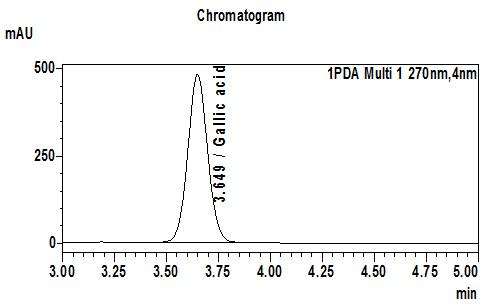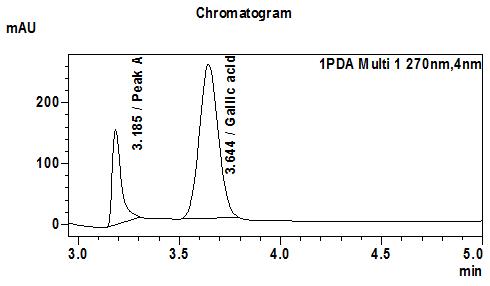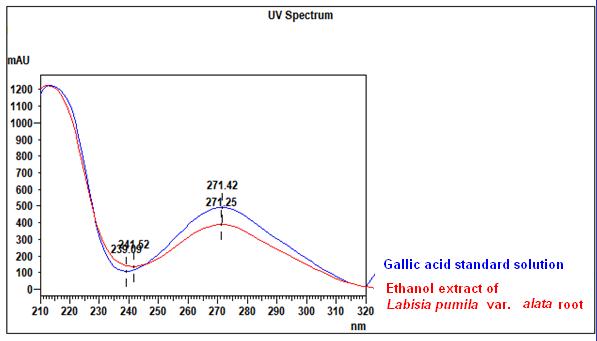Kacip Fatimah Root
Labisia pumila (Blume) Fern.-Vill var. alata (Scheff.) Mez
Primulaceae
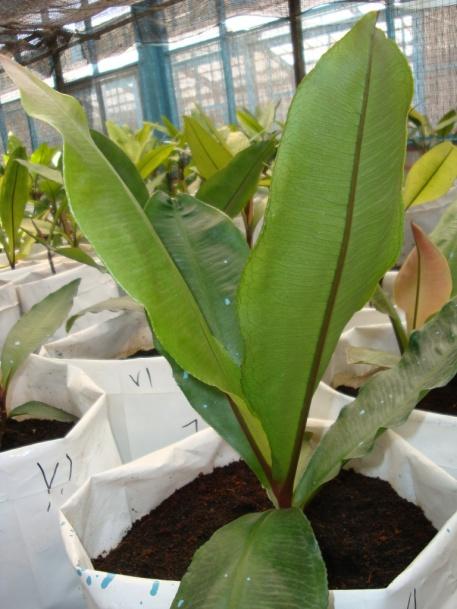
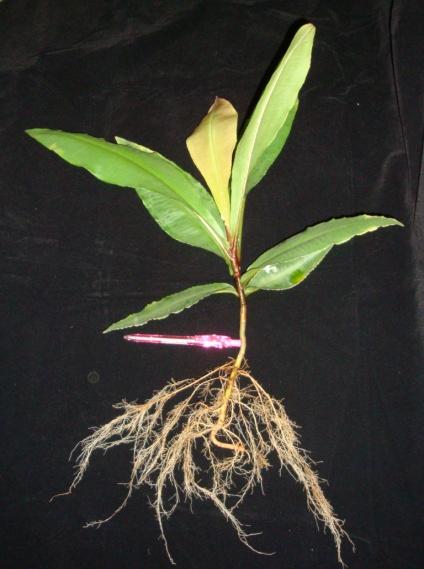
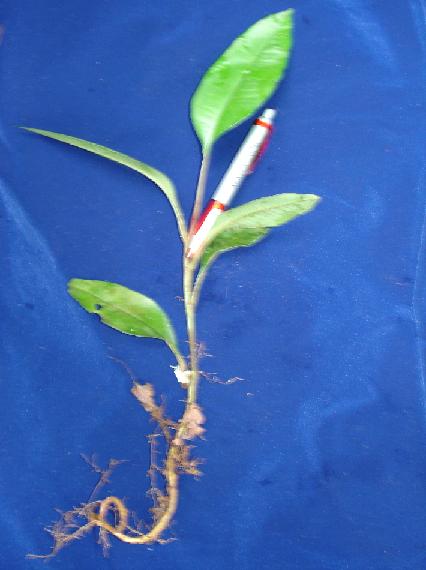
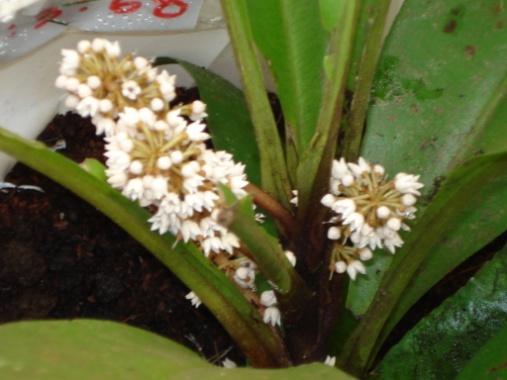
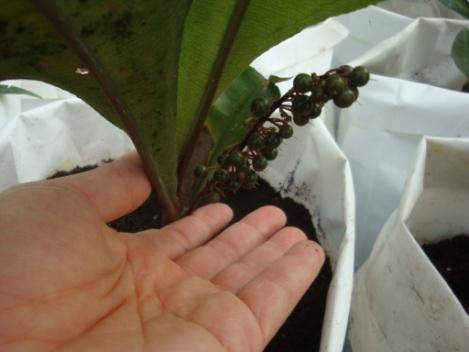
Figure 1 : L. pumila var. alata. (a) A 1-year old whole plant grown in soilless culture showing broadly winged petiole characteristic; (b) well established root system of 1-year old plant cultivated in soilless culture; (c) wild plant; (d) inflorescence axillary of approximately 5-8 cm long bearing white to pinkish white flowers; (e) subglobose fruits of 4-5 mm diameter, green when young and red when ripe. (Photos courtesy of Hawa ZE Jaafar, UPM, 2012)
DEFINITION
Kacip fatimah root consists of the stem and root of L. pumila (Blume) Fern.-Vill var. alata (Scheff.) Mez .
SYNONYM
Labisia pothoina Lindl.
VERNACULAR NAMES
Kacip fatimah, selusoh fatimah, selusuh fatimah, akar fatimah, kachit fatimah, kachip fatimah, kachip patimah, kunchi fatimah, pokok pinggang, rumput siti fatimah, rumput palis, tadah mata hari, mata pelandok rimba and bunga belangkas hutan (Malaysia) [ 1 , 2 , 3 ].
CHARACTER
The root is tough and woody. It is light brown in colour, has slight odour and is tasteless.
IDENTIFICATION
Plant morphology
Very slow growing erect 10-40 cm high or prostrate up to 60 cm long or longer, decumbent or creeping under shrubs. The leaves as simple more than 5 per plant, spirally arranged, elliptic or ovate; lamina (narrowly or broadly) elliptic or ovate 10-30 by 1.3-11 cm, herbaceous, chartaceous to subcoriaceous, base acute or obtuse, more or less decurrent, or sometimes slightly cordate, margin serrate, dentate, crenulate, subentire or entire, apex acuminate, acute or obtuse, midrib narrowly impressed above, secondary nerves anastomosing at 1-4 mm from margin; petioles 5-12 cm long with wing 3-5 mm wide at each side. Inflorescence axillary, panicles or racemes, with corymb-like fascicles of 2-9 flowers, 5-25 cm long; corymb and floral bracts narrowly triangular, 1-3 (to 5) mm long; pedicels 1-3 mm long. Flowers white or pinkish white, hermaphrodite, 5-merous, zygomorphic, glandular pusticulate, glabrous; sepals 5, basally connate for ⅓ to ½ of its length, segments valvate, lobes triangular 0.5-1 mm long, acute to acuminate, ovate or delate, valvate or imbricate in bud; petals, basally connate near the base, segments valvate, lobes ovate, 2-2.5 by 1-1.5 mm, apex subacute; in mature buds, just before anthesis subglobose, 1.5-2 mm long, top obtuse; stamens 5, 1-1.5 mm long, epipetalous, enclosed by the petals; filaments short c. 0.2 mm long, connective appendages 0.1-0.3 mm long, backside glandular pusticulate; anthers basifixed or sagittate about 0.8-1 mm long; ovary superior, broadly ovoid; placenta broadly ellipsoid; ovules 6-8, uniseriate; style filiform; stigma small, notched. Fruit drupaceous, subglobose to globose. Seed 1, subglobose to globose, ribbed; endosperm smooth, embryo transverse, cylindric [ 4 ].
Microscopy
The root powder has fairly abundant sclereids, which occur singly elongated, rectangular in outline. Lumen may be present or absent. Starch is sometimes present inside the large lumen. The abundant starch granules are simple and spherical to oval or sometimes elongated and rectangular in shape. No striation is present but a few starches have hilum. A group of cork cells, vessels with spiral thickening and cluster crystals of calcium oxalate are also present.
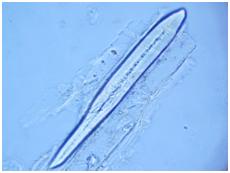
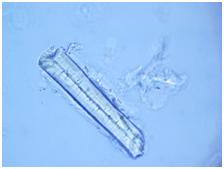
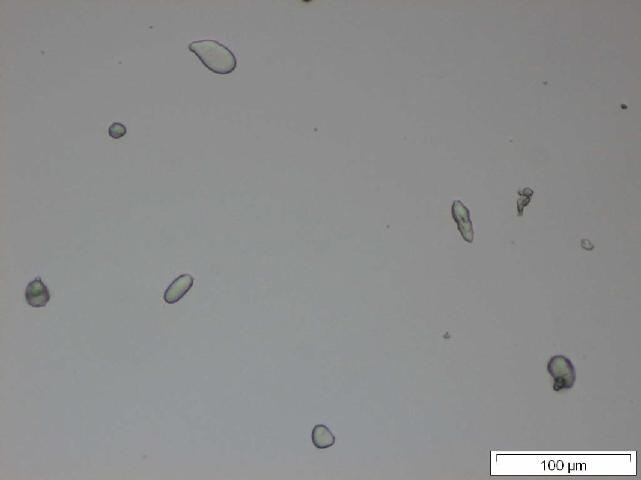
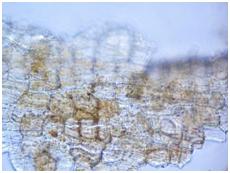
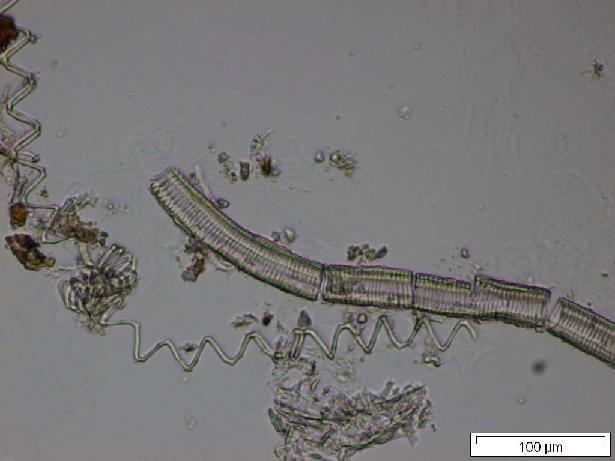
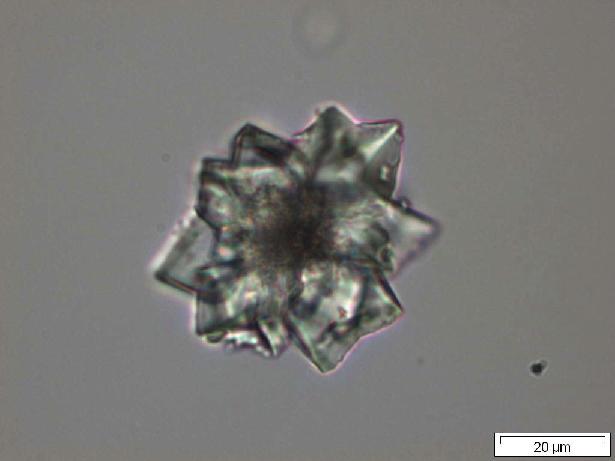
Figure 2 : Microscopic characters of L. pumila var. alata root powder. (a) Fusiform sclereid (magnification 400X); (b) rectangular sclereid (magnification 400X); (c) starch granules (magnification 100X); (d) cork cells (magnification 400X); (e) spiral vessel (magnification 100X); (f) calcium oxalate cluster crystal (magnification 400X).
Colour Test
Observed colour of solution after treatment with various reagents:
| H2SO4 (conc.) | Dark brown to black |
| HCl (conc.) | Dark brown |
| 5% NaOH | Dark brown |
| 5% KOH | Dark brown |
| 25% NH4OH | Dark brown |
| FeCI3 | Dark brown |
Thin Layer Chromatography (TLC)
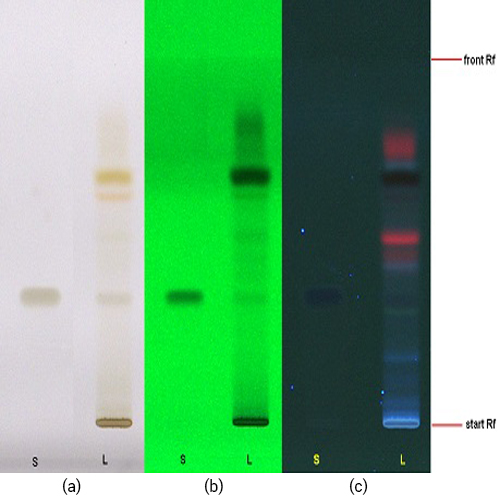
Figure 3 : TLC profiles of gallic acid (S) and methanol extract of L. pumila var. alata root (L) observed under (a) visible light, (b) UV at 254 nm, (c) UV at 366 nm.
| Test Solutions | Weigh about 4.0 g of L. pumila var. alata dried root powder in a 250 mL round bottom flask and add 15 mL of methanol into the flask. Reflux the sample for 1 hour and allow to cool. Filter the mixture and use the filtrate as the test solution. |
| Standard solution | Dissolve 2.0 mg gallic acid in 20 mL methanol to give 100 µg/mL. |
| Stationary Phase | HPTLC silica gel 60 F254, 5 x 10 cm |
| Mobile phase | Toluene-ethyl acetate-formic acid, 5:5:1 (v/v) |
| Application |
|
| Development distance | 7 cm |
| Drying | Air drying |
| Detection |
|
High Performance Liquid Chromatography (HPLC)
| Test solution | Extract about 5.0 g of L. pumila var. alata dried root powder with 100 mL of ethanol by reflux for 30 min. Filter the mixture through a filter paper. Evaporate the filtrate to dryness using a rotary evaporator. Then, dissolve 150.0 mg of the dried extract in 7.5 mL of methanol. Sonicate the mixture for 15 min and then centrifuge at 20,000 rpm for 15 min. Filter the supernatant through a 0.45 µm syringe filter and inject the filtrate into the HPLC column. |
| Standard solution | Dissolve 2.0 mg of gallic acid standard in 20 mL of methanol to produce 100 µg/mL solution. |
| Chromatographic system |
Detector: UV 270 nm Column: C18 (5 µm, 4.6 mm I.D x 150 mm) Column oven temperature: 30°C Flow rate: 1.0 mL/min Injection volume: 20 µL |
| Mobile Phase (isocratic mode) |
Isocratic elution using the mobile phase described below:
|
| System suitability requirement |
Perform at least five replicate injections of the gallic acid standard solution (100 µg/mL). The requirements of the system suitability parameters are as follow:
|
| Acceptance criteria |
|
PURITY TESTS
| Foreign Matter |
| Not more than 2% |
| Ash Contents | |
| Total ash | Not more than 7% |
| Acid-insoluble ash | Not more than 1% |
| Loss on Drying |
| Not more than 11% |
| Extractive Values | |
| Water-soluble extracts | |
| Hot method | Not less than 7% |
| Cold method | Not less than 7% |
| Ethanol-soluble extracts | |
| Hot method | Not less than 7% |
| Cold method | Not less than 5% |
SAFETY TESTS
| Heavy Metals | |
| Arsenic | Not more than 5.0 mg/kg |
| Mercury | Not more than 0.5 mg/kg |
| Lead | Not more than 10.0 mg/kg |
| Cadmium | Not more than 0.3 mg/kg |
| Microbial Limits | |
| Total bacterial count | Not more than 105 cfu/g |
| Total yeast and mould count | Not more than 104 cfu/g |
| Bile-tolerant gram negative | Not more than 104 cfu/g |
| Specific Pathogens | |
| Salmonella spp. | Absent in 25 g |
| Escherichia coli | Absent in 1 g |
| Staphylococcus aureus | Absent in 1 g |
| Pseudomonas aeruginosa | Absent in 1 g |
CHEMICAL CONSTITUENTS
Methanolic extracts of the roots of L. pumila var. alata has been found to contain flavonoids (e.g. kaempferol, myricetin, naringin and rutin) and other phenolics (e.g. gallic acid and pyrogallol) [ 5 ].
Dichloromethane extract of the roots of L. pumila var. alata has been found to contain (Z)-5-(pentadec-4’-enyl)benzene-1,3-diol, (Z)-5-(pentadec-8’-enyl)benzene-1,3-diol and (Z)-5-(pentadec-10’-enyl)benzene-1,3-diol [ 6 ].
MEDICINAL USES
Uses described in folk medicine, not supported by experimental or clinical data
Kacip fatimah is consumed by a new mother to regain body strength, delay fertility and contract the birth channel [ 7 ]. In Malaysia, water decoction of the root or whole plant is traditionally consumed by the Malay women for induction and facilitation of labour, as well as for the treatment of flatulence, dysentery, dysmenorrhoea, gonorrhoea and “sickness in the bones” [ 2 ].
Biological and pharmacological activities supported by experimental data
Antioxidant activity
Methanol extract of L. pumila var. alata stem and root inhibited 1,1-diphenyl-2-picrylhydrazyl (DPPH) free radical scavenging (37.2%-52.72%) and ferric reducing antioxidant potential (FRAP) (435.23%-537.65%) activities [ 5 ].
Antimicrobial activity
Methanol extracts of L. pumila var. alata stem and root (300 mg/disc) showed moderate inhibitory activity against the Gram-positive bacteria (Bacillus subtilis and Bacillus cereus) and Gram-negative bacteria (Enterobacter aerogenes, Escherichia coli and Klebsiella pneumonia) with inhibition zone diameters ranging from 0.79 to 0.94 cm and 0.50 to 1.11 cm, respectively [ 8 ].
Larvicidal activity
Methanol extract of L. pumila var. alata root showed relatively high larvicidal activity against Aedes aegypti with LC50 value of 205 mg/ml [ 9 ].
Cytotoxic activity
Ethanol and aqueous extracts of L. pumila var. alata root exhibited cytotoxic effect on Ishikawa cell line of human endometrial adenocarcinoma with IC50 of 582 mg/mL and 433 mg/mL, respectively [ 10 ].
Estrogenic activity
Ethanol extract of L. pumila var. alata root exhibited weak estrogenic activity in Ishikawa cell line of human endometrial adenocarcinoma at concentrations of 10-50 mg/mL [ 10 ].
Effect on bone
Freeze-dried water extract of L. pumila var. alata root (17.5 mg/kg/day) given via oral gavage to three-month old female Wistar ovariectomised rats for 8 weeks was able to prevent the changes in bone biochemical markers [ 11 ] and prevent estrogen-deficient osteoporosis [ 12 ].
Clinical studies
Clinical studies have been conducted using whole plant water extracts [ 13 , 14 ], however, none is available for the root extract.
SAFETY INFORMATION
Preclinical studies (Toxicological studies)
14-day oral toxicity study
Oral single dose acute toxicity study on female Sprague Dawley rats (aged between 8 and 12 weeks old) using aqueous mixture of L. pumila var. alata root powder showed no toxic effects on the parameters observed, including behaviours, body weight, food and water intake. All rats were observed for 14 days prior to necropsy. No death was found throughout the study period. Necropsy revealed no significant abnormality. Half lethal dose (LD50) is more than 2,000 mg/kg body weight [ 15 ].
Others (Adverse reaction, contraindication, side effect, warning, precaution)
Side effect L. pumila var. alata can cause contact dermatitis to hypersensitive people [ 16 ].
DOSAGE
The dosage of L. pumila var. alata root water extract has not been established.
STORAGE
Store below 30°C. Protect from light and moisture.
REFERENCES
- Stone BC. Notes on the genus Labisia Lindl. (Myrsinaceae). Malay Natural Journal. 1988;42:43-51.
- Burkill, IH. A dictionary of the economic products of the Malay Peninsula. Vol 2. Malaysia: Ministry of Agriculture. 1966;p.1311.
- Musa Y, Azimah K, Zaharah H. Tumbuhan ubatan popular Malaysia. Serdang: MARDI. 2009;p.69.
- Sunarno B. Revision of the genus Labisia (Myrsinaceae). Blumea. 2005;50:579-597.
- Ibrahim MH, Jaafar HZE. The relationship of nitrogen and C/N ratio with secondary metabolites levels and antioxidant activities in three varieties of Malaysian Kacip Fatimah (Labisia pumila Blume). Molecules. 2011;16:5514-5526.
- Jamal JA, Houghton PJ. Alkenyl resorcinols from Labisia pumila var. alata. Proceedings of Natural Products Research in Malaysia. Pulau Pinang: Universiti Sains Malaysia. 1999.
- Zakaria M, Mustafa AM. Traditional Malay medicinal plants. Kuala Lumpur: Fajar Bakti Sdn Bhd. 2010.
- Karimi E, Jaafar HZ, Ahmad S. Phytochemical analysis and antimicrobial activities of methanolic extracts of leaf, stem and root from different varities of Labisia pumila Benth.Molecules. 2011;16:4438-4450.
- Jantan I, Ping WO, Visuvalingam SD, Ahmad NW. Larvicidal activity of the essential oils and methanol extracts of Malaysian plants on Aedes aegypti. Pharmaceutical Biology. 2003;41(4):234-236.
- Jamal JA, Houghton PJ, Milligan SR, Jantan I. The oestrogenic and cytotoxic effects of the extracts of Labisia pumila var. alata and Labisia pumila var. pumila in vitro. Malaysian Journal of Medicine and Health Sciences. 2003;1:53-60.
- Shuid AN, Ping LL, Muhammad N, Mohamed N, Soelaiman IN. The effects of Labisia pumila var. alata on bone markers and bone calcium in a rat model of post-menopausal osteoporosis. Journal of Ethnopharmacology. 2011;133(2):538-542.
- Fathilah SN, Shuid AN, Mohamed N, Muhammad N, Soelaiman IN. Labisia pumila protects the bone of estrogen-deficient rat model: a histomorphometric study. Journal of Ethnopharmacology. 2012;294-299.
- Hussain NHN, Kadir AA, Bebakar WMW, Mohd DM, Shukor N, Kamaruddin NA, Mohamud, WNW. Pilot study on the safety and cardiovascular effects of BioLabisia™ on post-menopausal women. International Medical Journal. 2009;16(2):137-148.
- Kadir AA, Hussain NHN, Bebakar WMW, Mohd DM, Mohammad WMZW, Hassan II, Shukor N, Kamaruddin NA, Mohamud WNW. The effect of Labisia pumila var. alata on postmenopausal women: a pilot study. Journal of Evidence – Based Complementary Alternative Medicine. 2012;2012:216525.
- Teh BP, Hamzah NF, Rosli SNS, Yahaya MAF, Zakiah I, Murizal Z. Acute oral toxicity study of selected Malaysian medicinal herbs on Sprague Dawley rats . Institute for Medical Research, Ministry of Health; 2012. Repot No.: HMRC 11-045/01/LPA/SR/C.
- Jamal JA, Houghton, PJ, Ridzwan, R. “Contact dermatitis caused by Kacip Fatimah”. In Chang YS, Mastura M, Subramaniam V, Zainon AS (eds) towards bridging science and herbal industry. Kuala Lumpur: Forest Research Institute of Malaysia. 2001;p.77-80.

